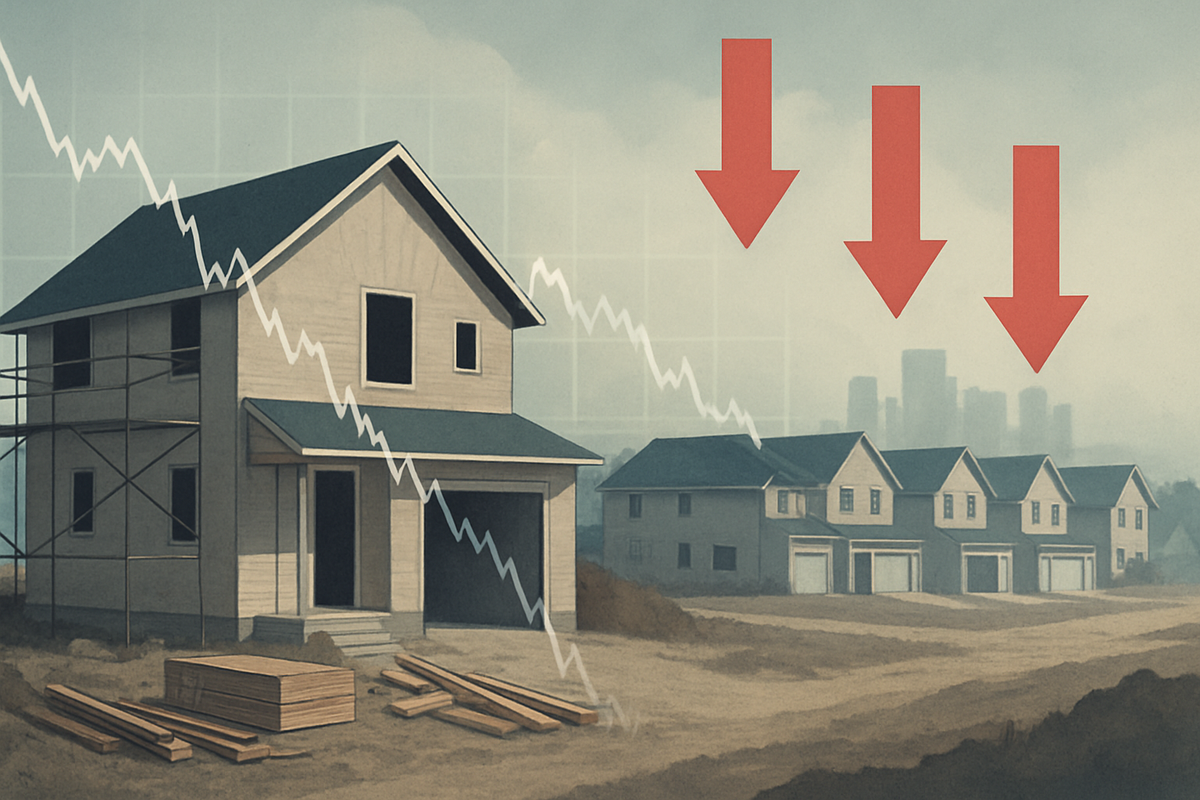
The real estate sector is currently navigating turbulent waters, as a recent wave of analyst downgrades for prominent homebuilding stocks has sent ripples of concern through the market. MarketBeat reports that these adjustments, occurring in October 2025, reflect a challenging outlook for homebuilders, driven by a confluence of persistent macroeconomic headwinds and evolving consumer behavior. While raising alarm bells for some, these downgrades also hint at potential recalibrations and emerging opportunities within the broader real estate landscape.
The immediate implication of these analyst actions has been a noticeable dampening of investor sentiment and a decline in the stock performance of several key players. This sentiment shift underscores a broader industry slowdown, with experts pointing to declining building permits and sustained affordability challenges as primary drivers. The market is now grappling with how homebuilders will adapt to this new environment, and what it means for the trajectory of housing supply and demand in the coming months.
Homebuilders Under Pressure: A Deep Dive into Recent Downgrades and Market Reactions
The recent analyst downgrades have cast a shadow over some of the nation's leading homebuilders, signaling a challenging period for the sector. In October 2025, companies such as Lennar Corp. (NYSE: LEN), PulteGroup Inc. (NYSE: PHM), and KB Home (NYSE: KBH) have been particularly impacted, experiencing significant revisions to their ratings and price targets. This wave of downgrades is not primarily due to company-specific missteps, but rather a reflection of a deteriorating macroeconomic environment for real estate and construction.
A notable instance occurred around October 9-10, 2025, when a CFRA analyst deemed PulteGroup "overvalued," contributing to a substantial drop in its share price. Similarly, KB Home faced multiple downgrades in late September and early October. Evercore ISI Group lowered its rating for KB Home from "Outperform" to "In-Line" on October 7, 2025, also reducing its price target. This followed a similar move by JP Morgan on September 29, 2025, which maintained a "Neutral" rating but cut its price target. Earlier in the year, on June 30, 2025, CFRA's Ana Garcia MSF had already downgraded KB Home to a "Sell." Even smaller players like Skyline Builders Group (NASDAQ: SKBL) felt the pinch, with Weiss Ratings reaffirming a "Sell" rating on October 14, 2025.
The market's reaction has been swift and pronounced. The S&P homebuilder sector experienced a sharp decline of over 9.6% in just four days around early October, translating to a market value loss exceeding $19.5 billion. This downturn is largely attributed to a confluence of factors: stubbornly high mortgage rates, persistent macroeconomic uncertainties, and cautious consumer behavior. While the average 30-year fixed mortgage rate eased slightly to approximately 6.25% in October 2025, it remains elevated, severely impacting affordability and dampening sales volumes. This has led to lower demand for new homes, directly affecting homebuilders' margins and earnings per share.
Adding to the pressure, there's been an increase in housing inventory and rising cancellation rates, with KB Home reporting a jump to 16% in Q1 2025 from 13% in the prior year. This indicates homes are staying on the market longer, potentially necessitating price reductions and further eroding profitability. External pressures also surfaced around October 9-10, 2025, with social media posts from prominent figures perceived as pressuring homebuilders to increase housing supply, further impacting market sentiment and adding to the complexity faced by these companies.
Navigating the Shifting Sands: Potential Winners and Losers in the Evolving Housing Market
The current wave of analyst downgrades is creating a clear delineation between potential winners and losers in the homebuilding and broader real estate sectors. Homebuilders heavily reliant on new construction in high-interest-rate environments are undoubtedly facing the brunt of the downturn. Companies like PulteGroup Inc. (NYSE: PHM), Lennar Corp. (NYSE: LEN), and KB Home (NYSE: KBH), which have seen direct downgrades and significant stock price declines, are wrestling with reduced demand, increased inventory, and compressed profit margins. Their ability to adapt quickly to changing buyer preferences and potentially pivot towards more affordable housing segments or alternative revenue streams will be crucial for their recovery. Those with higher debt loads or less diversified portfolios may find themselves in a more precarious position.
Conversely, this challenging environment could present opportunities for certain players or strategies. While direct homebuilding is under pressure, related sectors might see a resurgence. Real Estate Investment Trusts (REITs), for instance, are currently trading at a discount due to the homebuilding slowdown, potentially offering investors a chance to hedge their capital or find value. Companies specializing in renovation, remodeling, or property management might also see increased demand as fewer new homes are purchased and existing homeowners opt to improve their current residences. Additionally, builders with strong balance sheets and the flexibility to acquire distressed assets or land at lower prices during this period could emerge stronger when the market eventually stabilizes.
The long-term outlook for homebuilders will heavily depend on their strategic agility. Companies that can quickly adjust their building plans to focus on more affordable housing options, or those that can leverage innovative construction techniques to reduce costs, may find a path to sustained profitability. Furthermore, builders with a strong presence in regions experiencing continued population growth or those less sensitive to interest rate fluctuations might outperform their peers. The market's current state also underscores the importance of strong financial health and the ability to weather prolonged periods of reduced demand and tighter margins.
Moreover, the shift in market dynamics could favor companies involved in the rental housing market. As homeownership becomes less accessible for a segment of the population due to high prices and mortgage rates, demand for rental properties is likely to remain robust. This could benefit developers focused on multi-family units or companies that own and manage large rental portfolios. The ability to diversify revenue streams beyond traditional single-family home sales will be a critical differentiator for homebuilders seeking to thrive in this evolving landscape.
Broader Implications: Unpacking the Wider Significance of Homebuilding Downgrades
The analyst downgrades in the homebuilding sector are not isolated events but rather critical indicators of broader economic and industry trends with significant ripple effects. This downturn fits squarely into a narrative of tighter monetary policy and persistent inflation, which has led to elevated interest rates. These rates directly impact mortgage affordability, acting as a significant deterrent for prospective homebuyers and consequently dampening demand for new construction. The decline in building permits, now below long-term averages, underscores a systemic slowdown, suggesting the industry is indeed in a "near-depressive state" as some analysts have noted.
The ripple effects extend far beyond the immediate homebuilding companies. Suppliers of building materials, such as lumber, steel, and concrete, are likely to experience reduced demand, potentially leading to lower sales and profits for companies like Louisiana-Pacific Corporation (NYSE: LPX) or Vulcan Materials Company (NYSE: VMC). Mortgage lenders and financial institutions, including Wells Fargo & Company (NYSE: WFC) or JPMorgan Chase & Co. (NYSE: JPM), could see a decrease in new mortgage originations, impacting their revenue streams. Real estate agents and brokers may also face a slower market with fewer transactions. Furthermore, local economies reliant on construction jobs and property taxes could experience a slowdown, highlighting the interconnectedness of the housing market with the broader economic health.
Regulatory and policy implications are also at play. The Federal Reserve's rate cut in September 2025, with further cuts anticipated, offers a glimmer of hope for improved affordability. However, the impact is not immediate, and the efficacy of these cuts in stimulating buyer demand will be closely watched. There's also increasing pressure, as seen in recent public statements, for homebuilders to increase housing supply. While this could theoretically alleviate some price pressures, it must be balanced against current demand constraints and the financial viability for builders. Historically, similar periods of high interest rates and economic uncertainty have led to housing market corrections, often followed by periods of consolidation within the building industry. The current situation draws parallels to downturns experienced in the late 2000s, albeit with different underlying causes and market structures, suggesting that adaptation and resilience will be key.
The broader significance of these downgrades points to a necessary re-evaluation of growth strategies within the real estate sector. It highlights the sensitivity of the market to interest rate movements and the critical role of consumer confidence. As the industry navigates these challenges, the ability of policymakers, financial institutions, and homebuilders to collaborate on solutions that address affordability and sustainable growth will be paramount for mitigating long-term negative impacts and fostering a healthier housing ecosystem.
The Road Ahead: Exploring Future Scenarios and Emerging Opportunities
The current landscape of analyst downgrades for homebuilding stocks signals a period of significant transition for the real estate sector, prompting a critical look at what comes next. In the short term, homebuilders are likely to prioritize inventory management, potentially offering incentives or price adjustments to move existing homes and reduce carrying costs. We may also see a slowdown in new project starts as companies adopt a more cautious approach to capital deployment. The Federal Reserve's anticipated rate cuts in October and December 2025 offer a potential lifeline, but a significant resurgence in buyer demand is generally not expected until mortgage rates potentially drop to 5% or lower, which could take several quarters to materialize fully.
In the long term, this period of adjustment could necessitate strategic pivots and adaptations across the industry. Homebuilders may increasingly focus on more affordable housing segments, leveraging innovative construction techniques to reduce costs and cater to a wider demographic. Diversification into build-to-rent models or mixed-use developments could also become more prevalent as companies seek to mitigate reliance on traditional single-family home sales. For instance, companies like Invitation Homes Inc. (NYSE: INVH), specializing in single-family rentals, might see sustained demand. The emphasis will shift towards operational efficiency, robust balance sheets, and a flexible approach to market demands.
Emerging market opportunities, despite the current headwinds, are also on the horizon. The slowdown in homebuilding has led to Real Estate Investment Trusts (REITs) trading at a discount, presenting potential entry points for investors looking to hedge their capital or capitalize on undervalued assets. Furthermore, as new construction slows, the demand for renovations, remodeling, and property maintenance for existing homes could see an uptick, benefiting companies in those ancillary sectors. The underlying demand for housing, driven by population growth and demographic shifts, remains robust over the long term; the challenge lies in bridging the current affordability gap. Potential scenarios include a gradual recovery as interest rates stabilize and consumer confidence improves, or a more prolonged period of stagnation if economic uncertainties persist. Homebuilders that can innovate, adapt to evolving consumer needs, and maintain financial discipline are best positioned to navigate these challenges and emerge stronger.
Charting the Course: A Comprehensive Wrap-up of the Homebuilding Market's Future
The recent wave of analyst downgrades impacting the homebuilding sector serves as a stark reminder of the financial markets' sensitivity to macroeconomic shifts, particularly interest rate fluctuations and consumer sentiment. The key takeaway from this period of adjustment is that the real estate market is undergoing a fundamental recalibration, moving away from the rapid growth seen in previous years towards a more challenging, but potentially more sustainable, equilibrium. Homebuilders like Lennar Corp. (NYSE: LEN), PulteGroup Inc. (NYSE: PHM), and KB Home (NYSE: KBH) are at the forefront of this change, grappling with reduced demand, increased inventory, and the imperative to innovate their business models.
Moving forward, the market will be characterized by a heightened focus on affordability and strategic diversification. While the immediate outlook for new home sales remains subdued, the anticipated Federal Reserve rate cuts offer a glimmer of hope for a gradual recovery in buyer demand, albeit not an immediate one. Investors should closely monitor mortgage rate trends, inventory levels, and homebuilder earnings reports for signs of stabilization or strategic shifts. The resilience of the broader economy and the ability of homebuilders to adapt to evolving consumer preferences—potentially towards more affordable housing or rental options—will dictate the pace and shape of the recovery.
The lasting impact of these downgrades will likely be a more disciplined and innovative homebuilding industry. Companies that can streamline operations, manage debt effectively, and explore new market segments will be best positioned for long-term success. While the current environment presents significant challenges, it also fosters opportunities for strategic investments in undervalued assets, particularly within related real estate sectors like REITs. The coming months will be crucial for observing how these dynamics unfold, and how homebuilders respond to the pressures of a transformed housing market.
This content is intended for informational purposes only and is not financial advice


















